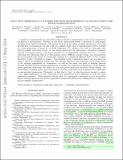| dc.contributor.author | Pober, Jonathan C. | |
| dc.contributor.author | Liu, Adrian Chi-Yan | |
| dc.contributor.author | Aguirre, James E. | |
| dc.contributor.author | Bowman, Judd D. | |
| dc.contributor.author | Bradley, Richard F. | |
| dc.contributor.author | Carilli, Chris L. | |
| dc.contributor.author | DeBoer, David R. | |
| dc.contributor.author | Jacobs, Daniel C. | |
| dc.contributor.author | McQuinn, Matthew | |
| dc.contributor.author | Morales, Miguel F. | |
| dc.contributor.author | Parsons, Aaron R. | |
| dc.contributor.author | Werthimer, Dan J. | |
| dc.contributor.author | Dillon, Joshua Shane | |
| dc.contributor.author | Tegmark, Max Erik | |
| dc.contributor.author | Hewitt, Jacqueline N | |
| dc.date.accessioned | 2014-07-22T14:49:59Z | |
| dc.date.available | 2014-07-22T14:49:59Z | |
| dc.date.issued | 2014-01 | |
| dc.date.submitted | 2013-10 | |
| dc.identifier.issn | 0004-637X | |
| dc.identifier.issn | 1538-4357 | |
| dc.identifier.uri | http://hdl.handle.net/1721.1/88463 | |
| dc.description.abstract | A number of experiments are currently working toward a measurement of the 21 cm signal from the epoch of reionization (EoR). Whether or not these experiments deliver a detection of cosmological emission, their limited sensitivity will prevent them from providing detailed information about the astrophysics of reionization. In this work, we consider what types of measurements will be enabled by the next generation of larger 21 cm EoR telescopes. To calculate the type of constraints that will be possible with such arrays, we use simple models for the instrument, foreground emission, and the reionization history. We focus primarily on an instrument modeled after the ~0.1 km[superscript 2] collecting area Hydrogen Epoch of Reionization Array concept design and parameterize the uncertainties with regard to foreground emission by considering different limits to the recently described "wedge" footprint in k space. Uncertainties in the reionization history are accounted for using a series of simulations that vary the ionizing efficiency and minimum virial temperature of the galaxies responsible for reionization, as well as the mean free path of ionizing photons through the intergalactic medium. Given various combinations of models, we consider the significance of the possible power spectrum detections, the ability to trace the power spectrum evolution versus redshift, the detectability of salient power spectrum features, and the achievable level of quantitative constraints on astrophysical parameters. Ultimately, we find that 0.1 km[superscript 2] of collecting area is enough to ensure a very high significance ([> over ~] 30σ) detection of the reionization power spectrum in even the most pessimistic scenarios. This sensitivity should allow for meaningful constraints on the reionization history and astrophysical parameters, especially if foreground subtraction techniques can be improved and successfully implemented. | en_US |
| dc.language.iso | en_US | |
| dc.publisher | IOP Publishing | en_US |
| dc.relation.isversionof | http://dx.doi.org/10.1088/0004-637X/782/2/66 | en_US |
| dc.rights | Creative Commons Attribution-Noncommercial-Share Alike | en_US |
| dc.rights.uri | http://creativecommons.org/licenses/by-nc-sa/4.0/ | en_US |
| dc.source | arXiv | en_US |
| dc.title | WHAT NEXT-GENERATION 21 cm POWER SPECTRUM MEASUREMENTS CAN TEACH US ABOUT THE EPOCH OF REIONIZATION | en_US |
| dc.type | Article | en_US |
| dc.identifier.citation | Pober, Jonathan C., Adrian Liu, Joshua S. Dillon, James E. Aguirre, Judd D. Bowman, Richard F. Bradley, Chris L. Carilli, et al. “WHAT NEXT-GENERATION 21 Cm POWER SPECTRUM MEASUREMENTS CAN TEACH US ABOUT THE EPOCH OF REIONIZATION.” The Astrophysical Journal 782, no. 2 (February 20, 2014): 66. | en_US |
| dc.contributor.department | Massachusetts Institute of Technology. Department of Physics | en_US |
| dc.contributor.department | MIT Kavli Institute for Astrophysics and Space Research | en_US |
| dc.contributor.mitauthor | Dillon, Joshua Shane | en_US |
| dc.contributor.mitauthor | Hewitt, Jacqueline N. | en_US |
| dc.contributor.mitauthor | Tegmark, Max Erik | en_US |
| dc.relation.journal | The Astrophysical Journal | en_US |
| dc.eprint.version | Original manuscript | en_US |
| dc.type.uri | http://purl.org/eprint/type/JournalArticle | en_US |
| eprint.status | http://purl.org/eprint/status/NonPeerReviewed | en_US |
| dspace.orderedauthors | Pober, Jonathan C.; Liu, Adrian; Dillon, Joshua S.; Aguirre, James E.; Bowman, Judd D.; Bradley, Richard F.; Carilli, Chris L.; DeBoer, David R.; Hewitt, Jacqueline N.; Jacobs, Daniel C.; McQuinn, Matthew; Morales, Miguel F.; Parsons, Aaron R.; Tegmark, Max; Werthimer, Dan J. | en_US |
| dc.identifier.orcid | https://orcid.org/0000-0002-4117-570X | |
| dc.identifier.orcid | https://orcid.org/0000-0003-3336-9958 | |
| dc.identifier.orcid | https://orcid.org/0000-0001-7670-7190 | |
| mit.license | OPEN_ACCESS_POLICY | en_US |
| mit.metadata.status | Complete | |
